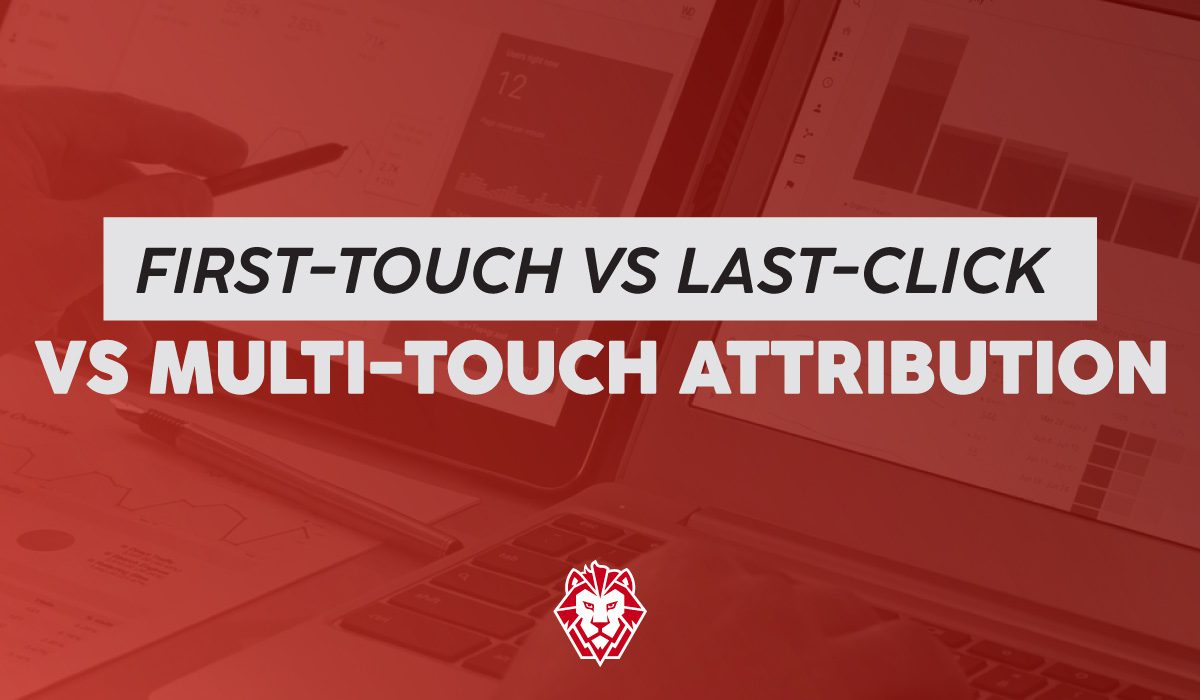Marketing leaders, their teams, and the sales team they support are often torn between first touch, last-click, and multi-touch attribution. First touch is considered by most to be the easiest for marketing teams to implement, last-click is the most direct and easiest to pull from Google Analytics, but multi-touch attribution, while more accurate, can be harder to implement among sales and marketing teams alike. Marketing leaders succumbing to the trap of simpler analytics are leaving both budget and ROI on the table. Consider the following:
First thing’s first: what’s what?
To be clear, last-click attribution is what most marketers are used to utilizing in their analytics. Setting up goals in Google Analytics and tracing conversions back to their respective origins is a fairly simple endeavor that even the most novice of Analysts will be able to execute. It’s also to explain to a CEO, CFO, or Board of Directors:
“we paid $5,000 for this PPC campaign and it generated $10,000 in sales.” The focus of last-click attribution campaigns revolves around keyword and
conversion rate optimization to refine the bottom of the sales funnel. Sadly, those numbers don’t tell the whole story. Many marketing leaders include retargeting metrics in their PPC reports, skewing the data and negating the impact of the first touch that brought the lead into the pipeline in the first place. First-touch requires a bit more effort internally, but tracking it gives marketing leaders a better idea of how to allocate marketing dollars in the future. First-touch attribution is the go-to metric for sales teams in almost every vertical and is ideal when the primary objective is to fill the top of a brand’s sales funnel.
But wait, there’s more!
Multi-touch attribution is more difficult to track compared to first-touch and last-click attribution, but offers the most complete snapshot of the buyer’s journey to purchase. There are a few ways that marketing leaders can track multi-touch attribution through Google Analytics, including Linear Allocation, Time Depreciation, and Position Based Allocation. Let’s take a deeper dive into each of them:
Linear Allocation
Linear is the simplest multi-touch attribution model to implement. Linear attribution credits each touchpoint equally when in consideration for marketing budget allocation. While simple, this model offers some heavy limitations. It’s important to remember that not all touch points are created equal. Touch points that “move the chains” for example, don’t receive any extra weight or value in the equation in direct comparison with touch points that failed to move a prospect further down the sales funnel.
Time Depreciation
The time depreciation multi-touch attribution is similar to last-touch attribution in that the model credits the more recent touch points at an escalated value compared to earlier touch points in the buyer’s journey to purchase. This model is more effective in longer sales cycles with leads that require more nurturing; hence the emphasis on the bottom of the sales funnel for budget allocation. One alternative here that we would advocate for a more effective alternative for the time depreciation method of multi-touch attribution is to weight credit more heavily for key transitions; such as emphasizing the first touch, lead generation, movement toward a purchase decision (aka opportunity), and the close (cha-ching!).
Position-Based Allocation
Within the Position-Based Allocation model of multi-touch attribution, 40% of the credit is allocated to both the first and last touch points, while the remaining 20% is distributed evenly among social and email channels. Some models skew position-based allocation even further to as much as 90% for the first and last touch points and as little as 10% for the social and email marketing that continues to move prospects down the funnel. Marketing leaders utilizing Position-Based Allocation will need to continue to closely monitor their analytics in order to discern the best ratio for their specific marketing campaigns.
Full-path Attribution
Full-path attribution is by far the most complex attribution method and perhaps the most difficult to implement. Full-path attribution requires the complete buy-in of both the sales and marketing teams. Full-path attribution tracks the first touch, lead creation, opportunity creation, and customer close stages. Each stage typically receives 22.5% of the credit for the sale, with the last 10% distributed among the remaining touch points. In our opinion, the full-path attribution model is the most reliable and accurate model of multi-touch attribution for marketing leaders to rely upon- assuming it can be implemented and tracked correctly within the organization.
While there’s no universal right answer, it’s clear that marketing leaders are best served to look well beyond the simplicity of first-touch and last-click attribution. Facebook and Google are both racing to support more intelligent models of multi-touch attribution, and with good reason- it will ensure that marketers keep investing their budgets with the global behemoths far into the foreseeable future.
Facebook recently announced Offline Events, and Google is expected to announce its own version of offline event tracking for brick+mortar advertisers in the near future.
How do you go about tracking your brand’s sales and the marketing campaigns that drive them?
Contact Fidelitas to see if you qualify for a complimentary marketing audit!
